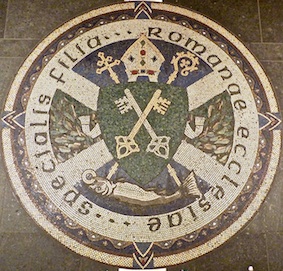History"The Roman Catholic Church in Great Clyde Street is justly considered one of the finest ecclesiastical edifices in the city, and occupies a prominent site on the north bank of the river. The exterior is very ornamental, and is fitted up in a plain manner, unlike the general appearance of Roman Catholic churches. The designs were furnished by Mr. Gillespie Graham, architect, Edinburgh." (From Sketches of the History of Glasgow, 1847.)
This description of St. Andrew's Cathedral shows the impact that the building of this Church had on the minds of the people of Glasgow . The driving force behind the building was a priest from the Enzie of Banff, Rev. Andrew Scott. He had been given the care of the Catholics of Glasgow in 1805 and was determined to build a Church that would serve the needs of the growing Catholic population of the city. The foundation stone was laid in June 1814. On December 22nd 1816, Holy Mass was celebrated for the first time within its walls. For the first two centuries after the Reformation there was practically no Catholic presence in Glasgow, but by the end of the 18th century Glasgow's industrial expansion was attracting many Catholic workers from Ireland and parts of the Scottish Highlands. Scotland ’s Catholic Hierarchy was restored in 1878, and Charles Eyre was named the first post-Reformation Archbishop of Glasgow. In 1884 the Chapter of Canons was re-erected and subsequently St. Andrew's became the Cathedral of the re-established Archdiocese. In 1947, with the establishment of the new Dioceses of Motherwell and Paisley, the Archdiocese of Glasgow recovered the metropolitan status which it had had before the Reformation and St. Andrew's became a Metropolitan Cathedral. St Andrew’s Cathedral Parish St Andrew’s Parish traces its origins to the appointment of a priest for Glasgow in 1792. That year, two hundred people came to the opening Mass in a rented hall in Mitchell Street. Five years later, new premises in the Calton area provided for 600 people each Sunday. In 1814, when the number of communicants recorded was 3,000, the decision was taken to build a new church in Clyde Street. Since then, the opening of new parishes and the redevelopment of the city centre have depleted the population of the Cathedral parish, but the small community of faithful parishioners is augmented by the numbers from elsewhere, some of whom travel considerable distances to assist with the celebration of the liturgy and the care of the fabric. Shoppers, workers, students, tourists and passers-by are all attracted to the Cathedral — for quiet prayer, for Mass, or for the Sacrament of Reconciliation. And of course there are the frequent major liturgies celebrated by the Archbishop and groups from the Archdiocese, which always ensure a full house. |
Merchant City - Old Glasgow Sights
Architectural Guide to the Old Heart of Glasgow TheGlasgowStory
Tells the story of Glasgow in words and pictures |

